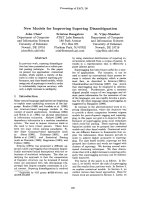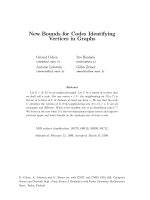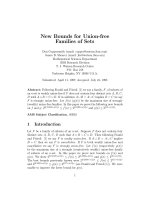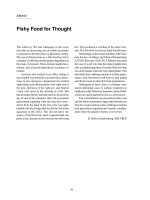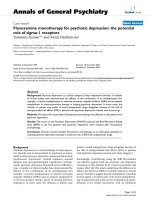Báo cáo y học: "New names for old strains? Wolbachia wSim is actually wRi" ppt
Bạn đang xem bản rút gọn của tài liệu. Xem và tải ngay bản đầy đủ của tài liệu tại đây (74.26 KB, 2 trang )
Genome Biology 2005, 6:401
comment
reviews
reports
deposited research
interactions
information
refereed research
Correspondence
New names for old strains? Wolbachia wSim is actually wRi
Iñaki Iturbe-Ormaetxe, Markus Riegler and Scott L O’Neill
A response to Serendipitous discovery of Wolbachia genomes in multiple Drosophila species by SL Salzberg, JC
Dunning Hotopp, AL Delcher, M Pop, DR Smith, MB Eisen and WC Nelson. Genome Biology 2005, 6:R23
Address: School of Integrative Biology, The University of Queensland, St Lucia, Brisbane, QLD 4072, Australia.
Correspondence: Scott O’Neill. E-mail:
Published: 24 June 2005
Genome Biology 2005, 6:401 (doi:10.1186/gb-2005-6-7-401)
The electronic version of this article is the complete one and can be
found online at />© 2005 BioMed Central Ltd
A recent paper published by Salzberg et
al. [1] reports the discovery, assembly
and comparative analysis of three
partial Wolbachia endosymbiont
genomes. These data were retrieved
from the Trace Archive [2] from
sequencing projects that were focused
on the endosymbiont hosts -
Drosophila simulans, D. ananassae
and D. mojavensis - using the fully
sequenced wMel Wolbachia genome
[3] as a probe. Salzberg et al. refer to
these partial genomes as belonging to
Wolbachia strains wSim, wAna and
wMoj respectively [1]. These strain
names are new constructions and it
appears that the annotated wSim
genome sequence is essentially identical
to the previously described wRi strain
[4] and should be named accordingly.
There is a large body of previous work
on the biology of Wolbachia infections
of D. simulans. To date, five Wolbachia
strains have been described from
D. simulans (for a review see [5]), three
of them belonging to group A, wAu [6],
wRi [7] and wHa [4], and two belong-
ing to group B, wNo [8] and wMa [9].
When the partial genome sequence of
wSim [1] is compared to previously
published sequences of the different
D. simulans Wolbachia strains, it is
clear that wSim is most likely to be the
wRi Wolbachia strain that has been
extensively studied over the years.
Blastn analysis of numerous wRi
sequences available at GenBank (acces-
sion numbers X61770, 16S rRNA;
AB002288, groES and groEL;
AB036661, bacteriophage WO gene for
capsid protein; AF348330, ubiA, rbfA,
infB, nusA, and acrD genes; AJ012073,
glnA and dnaA genes and two genes
encoding hypothetical proteins; and
AJ580923, wspB gene) reveals that the
wRi sequences are 99-100% identical
to the partially assembled wSim
genome [1]. On the basis of the molecu-
lar data publicly available in National
Center of Biotechnology Information
(NCBI) databases it is apparent that
the strain designated as wSim by
Salzberg et al. [1] is actually wRi. This
strain was first described phenotypi-
cally by Hoffmann et al. in 1986 [7] in
D. simulans collected in Riverside, Cal-
ifornia. wRi is characterized by the
ability to induce high levels of cytoplas-
mic incompatibility (CI) in its native
D. simulans host [7] and has the ability
to spread quickly through host popula-
tions by the induction of CI [10,11].
Biogeographic studies have revealed
that wRi is currently the most abun-
dant strain infecting continental popu-
lations of D. simulans [12].
Finally, the Trace Archive for D. simu-
lans contains reads from various
D. simulans lines [13] of different
biogeographic origin: wsim501 and
sim6, both North American and most
likely infected by wRi, and simNC48S
from New Caledonia and potentially
infected with wNo and wHa [12].
Therefore, it would be helpful if the
authors could clarify which Trace data
were used for the assembly of the wSim
genome, as it might be possible that the
assembly reported is chimeric, contain-
ing predominantly sequences from wRi
and possibly some sequence from other
Wolbachia strains.
While the discovery of these partial
genome sequences in the Trace Archive
is an exciting development, it is impor-
tant that the finding is connected to the
large established literature in this field
if the data is to be of most value to the
scientific community.
Julie Dunning Hotopp, William C
Nelson and Steven L Salzberg respond:
We are aware that our newly discov-
ered Wolbachia strain from the
ongoing D. simulans sequencing
project, which we have designated
wSim [1], might be the same as wRi, as
Iturbe-Ormaetxe et al. claim. Unfortu-
nately, the evidence to support this
claim, which is entirely based on
401.2 Genome Biology 2005, Volume 6, Issue 7, Article 401 Iturbe-Ormaetxe et al. />Genome Biology 2005, 6:401
sequence similarity, fails to distinguish
it from other hypotheses. Iturbe-
Ormaetxe et al. searched wSim against
fragments of several D. simulans Wol-
bachia strains and found that wRi was
the best match; from this they conclude
that wSim and wRi are the same. If one
searches these same wRi fragments
against wAna, however, one finds an
even closer match to wAna.
The small number of wRi genomic
fragments available in GenBank (repre-
senting less than 18 kilobases (kb), not
‘numerous sequences’ despite the con-
tention of Iturbe-Ormaetxe et al.) are
diverging too slowly to be used for
definitive strain identification; in some
cases even the wRi and wMel
sequences cannot be differentiated.
The wsp gene is simply missing from
our wSim assembly, but is 99.9% iden-
tical between wAna and wRi. The wRi
sequence of wspB is 99.2% identical
over 788 base-pairs (bp) to wAna and
98% identical over 226 bp to wSim.
The two longest genome fragments of
wRi, AF348330 (9,235 bp) and
AJ012073 (4,838 bp), match wSim and
wAna equally well. Clearly, wRi, wSim,
and wAna are closely related, as dis-
cussed in Table 2 of our paper [1], but if
one uses sequence identity to assign
strain designations, then wRi looks
more like wAna than wSim.
As should be apparent from this analysis,
the assertion made by Iturbe-Ormaetxe
et al. that wSim = wRi rests on a
logical fallacy; that is, that if the best
unidirectional BLAST matches of
genome A (wSim) correspond to
genome B (wRi), then A = B. This
ignores that fact genome B might have
a better match to genome C - in this
case wAna. Even more critical is the
fact that only a tiny fraction of wRi
has been sequenced. The BLAST
analysis shows only that wSim and
wRi are highly similar across a few
sequence fragments representing less
than 1.5% of their genomes.
We are aware that D. simulans has
been reported to carry the wRi strain
as well as the strain we designate
wSim, and that some of the sequenced
D. simulans strains carry the white
mutation [13,14]. It should be noted,
however, that although the D. simu-
lans sequencing project included a
mixture of three Drosophila strains,
virtually all (99.9%) of the wSim
sequences came from just one strain,
sim6; thus both wSim and wRi were
found in the California population of
D. simulans. Neither this nor the
BLAST alignments are, however, suffi-
cient evidence to collapse the strains
into one: Wolbachia species from
closely related insect species often
retain different strain identifiers [15-
17] despite sharing some identical gene
sequences. This is important because
sometimes these Wolbachia infections
result in different host phenotypes
[16]. Less commonly, Wolbachia
species with identical wsp genes iso-
lated from the same insect species (for
example, D. simulans) retain different
strain designations [15].
This nomenclature is also common in
other prokaryotes. Organisms with
identical multi-locus sequencing typing
(MLST) profiles isolated from the same
geographical area will be given different
strain designations to preserve informa-
tion about their origin. This may be
important if they have genomic
rearrangements and single-nucleotide
polymorphisms (SNPs) that confer
different phenotypes. In Wolbachia,
genomic rearrangements appear
common [1,3], which may support the
maintenance of separate strain designa-
tions to differentiate ancestry. In the
absence of complete genome sequences,
definitive genotyping assays, or pheno-
typic characterization of wSim, resolv-
ing strain differences is clearly
complicated and beyond the scope of
our paper.
Julie Dunning Hotopp, William C Nelson and
Steven L Salzberg
Correspondence should be sent to Steven L
Salzberg: Center for Bioinformatics and Com-
putational Biology, University of Maryland
Institute for Advanced Computer Studies,
University of Maryland, College Park,
MD 20742, USA. E-mail:
References
1. Salzberg SL, Dunning Hotopp JC, Delcher
AL, Pop M, Smith DR, Eisen MB, Nelson
WC: Serendipitous discovery of Wol-
bachia genomes in multiple Drosophila
species. Genome Biol 2005, 6:R23.
2. Trace Archive v.3
[ />3. Wu M, Sun LV, Vamathevan J, Riegler M,
Deboy R, Brownlie JC, McGraw EA,
Martin W, Esser C, Ahmadinejad N, et al.:
Phylogenomics of the reproductive
parasite Wolbachia pipientis wMel: a
streamlined genome overrun by
mobile genetic elements. PLoS Biol
2004, 2:E69.
4. O’Neill SL, Karr TL: Bidirectional
incompatibility between conspecific
populations of Drosophila simulans.
Nature 1990, 348:178-180.
5. Merçot H, Charlat S: Wolbachia infec-
tions in Drosophila melanogaster and
D. simulans: polymorphism and levels
of cytoplasmic incompatibility. Genet-
ica 2004, 120:51-59.
6. Hoffmann AA, Clancy D, Duncan J: A nat-
urally-occurring Wolbachia infection
in Drosophila simulans that does not
cause cytoplasmic incompatibility.
Heredity 1996, 76:1-8.
7. Hoffmann AA, Turelli M, Simmons GM:
Unidirectional incompatibility between
populations of Drosophila simulans.
Evolution 1986, 40:692-701.
8. Merçot H, Llorente B, Jacques M, Atlan A,
Montchamp-Moreau C: Variability
within the Seychelles cytoplasmic
incompatibility system in Drosophila
simulans. Genetics 1995, 141:1015-1023.
9. Giordano R, O’Neill SL, Robertson HM:
Wolbachia infections and the expres-
sion of cytoplasmic incompatibility in
Drosophila sechellia and D. mauritiana.
Genetics 1995, 140:1307-1317.
10. Turelli M, Hoffmann AA: Rapid spread of
an inherited incompatibility factor in
California Drosophila. Nature 1991,
353:440-442.
11. Turelli M, Hoffmann AA: Cytoplasmic
incompatibility in Drosophila simulans:
dynamics and parameter estimates
from natural populations. Genetics
1995, 140:1319-1338.
12. Ballard JWO: Sequential evolution of a
symbiont inferred from the host:
Wolbachia and Drosophila simulans.
Mol Biol Evol 2004, 21:428-442.
13. Washington University in St Louis
Genome Sequencing Center: D. simu-
lans [ />jects/simulans/index.php?species=1]
14. Hoffmann AA, Turelli M, Harshman LG:
Factors affecting the distribution
of cytoplasmic incompatibility in
Drosophila simulans. Genetics 1990,
126:933-948.
15. Dyer KA, Jaenike J: Evolutionarily stable
infection by a male-killing endosym-
biont in Drosophila innubila: molecu-
lar evidence from the host and
parasite genomes. Genetics 2004,
168:1443-1455.
16. Jiggins FM, Bentley JK, Majerus ME, Hurst
GD: Recent changes in phenotype
and patterns of host specialization in
Wolbachia bacteria. Mol Ecol 2002,
11:1275-1283.
17. Kikuchi Y, Fukatsu T: Diversity of Wol-
bachia endosymbionts in het-
eropteran bugs. Appl Environ Microbiol
2003, 69:6082-6090.

